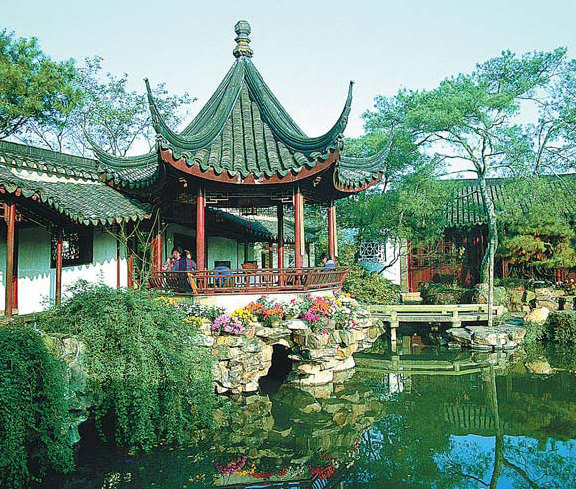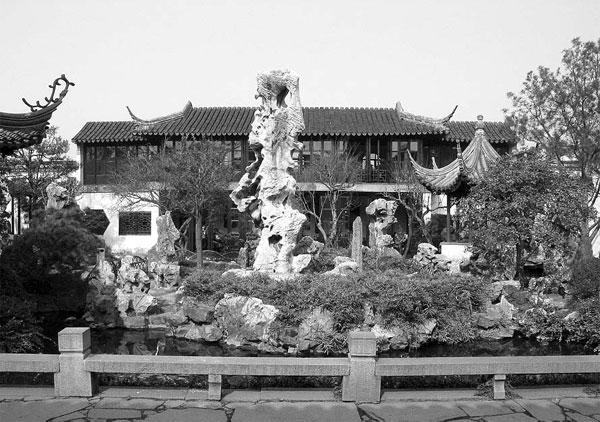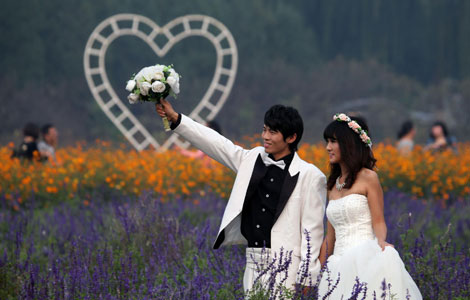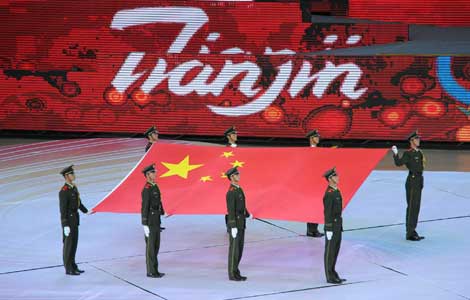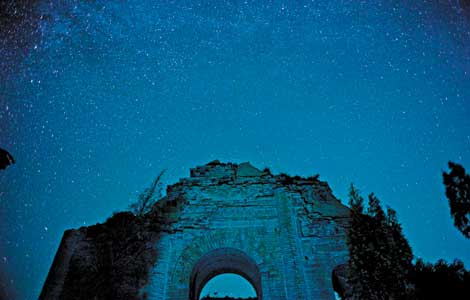Gardens put history and culture in perspective
Updated: 2013-10-07 07:24
By Peng Yining (China Daily)
|
|||||||||
The beauty of classical designs casts its influence on modern architecture beyond China, reports Peng Yining.
When he was designing the garden for architect I. M. Pei's Fragrant Hill Hotel in Beijing in 1983, Liu Shaozong could see the image of classical gardens in Jiangsu province in his mind.
Liu first saw the gardens in 1952, when he was a senior student at the architecture school of Tsinghua University and went to Jiangsu to sketch historical sites.
"The gardens were small but amazingly beautiful. I ran out of room in my sketch book to record everything I saw," Liu said. "So when I. M. Pei asked my opinion on the hotel's landscape design, I immediately thought of the classical gardens.
|
A section of the Master of Nets Garden in Suzhou, Jiangsu province, is revived in the Ming Xuan classical Chinese garden at the Metropolitan Museum of Art in New York. Photo by Lou Qingxi for China Daily |
"They just popped into my mind, even 30 years after I had first seen them," said the 81-year-old landscape designer who is based in Beijing. "I am still stunned. The beauty of classical Chinese gardens is not diminished by time. Even better, they still inspire architects and designers today."
Located in the leafy mountainous area of Beijing's western suburbs, the Fragrant Hill Hotel features whitewashed plaster walls and dark gray clay tiles, as used in traditional construction all over Suzhou, which is famous for its centuries-old private gardens.
Pei came from a prominent family in Suzhou and he spent a few years during his childhood at his family's estate, the Lion Grove Garden, one of the most famous classical Chinese gardens and a UNESCO World Heritage site. "Living in a classical garden did have an influence on Pei's work," Liu said. "The gardens also inspired me to build the same style landscape to match Pei's hotel."
Liu built a pond in the middle of the garden, and said such ponds were commonly used in classical Jiangsu gardens to visually widen the space using reflections on water. He also copied the Guan Yun Feng, or Cloud Capped Peak, his favorite rockery in Suzhou's Lingering Garden, and named it Guan Yun Luo Ying, which means the shadow of Guan Yun Feng.
The hotel won a National Honor Award from the American Institute of Architects in 1984 and its garden has become a symbol of the complex.
"The hotel is a typical combination of modern technology and the essence of Chinese vernacular architecture," Liu said. "That combination is now widely accepted, both domestically and abroad."
On a misty morning in early September, huge pine trees at the Humble Administrator's Garden, another UNESCO World Heritage site in Suzhou, still dripped after an early rain.
There weren't many visitors to the garden, whose name is derived from the famous poetic phrase, "a humble way of being an administrator".
The air was filled with the pleasant aroma of sweet osmanthus, the city flower of Suzhou.
Surrounded by pavilions with curved rooftops, small stone bridges and verandas, lotus flowers floated in the central pond. Raindrops rolled on the lotus leaves as the morning breeze blew, some dropping into the water and startling the golden carp.
The weather was cool and only the chirp of cicadas reminded visitors that summer had not yet ended.
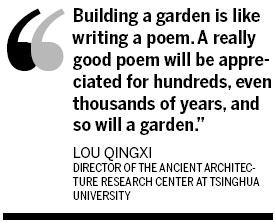
"The garden is very, very Chinese," said Sarah Loren, a 56-year-old tourist from the United States. "It is small but pretty. Living here must be good for the soul."
Built during the 16th and 17th centuries of the late Ming (1368-1644) and early Qing (1644-1911) dynasties, Jiangsu's gardens represent the elite of classical Chinese gardening and served as a prime exemplar for their northern counterparts, the Ming and Qing imperial gardens, according to Lou Qingxi, director of the ancient architecture research center at Tsinghua University.
He said the city of Suzhou inherited the largest and best-preserved collection of gardens and it could be called the city of gardens.
Lou said the classical gardens are works of art. "Walking in the Humble Administrator's Garden is like taking a stroll through a painting," he said. "And the painting changes as the weather and season varies."
The typical gardens in the region are small in scale but adorned with picturesque scenery of steep cliffs and deep gorges beside clear streams and emerald pools, Lou said. The best garden should have such architectural elements such as hills, ponds, pavilions, halls and verandas laid out in a way that offers ever-refreshing, enchanting and kaleidoscopic scenes that do not fall into any pre-existing norm.
"Building a garden is like writing a poem. A really good poem will be appreciated for hundreds, even thousands of years, and so will a garden," he said. "People admire a pretty, well-designed pavilion which was built 500 years ago. This is why the centuries-old art of classical Chinese gardens is still accepted and copied today."
Adjacent to the Humble Administrator's Garden, the Suzhou Museum, also designed by I. M. Pei, has the characteristics of a garden of Suzhou style, including the symbolic white walls and gray tiles. Instead of using traditional clay tiles, Pei used gray granite for the roof. A modern steel structure was also used for the new museum in place of traditional wooden roof beams.
As well as the museum, many other facilities in Suzhou are inspired by the traditional gardens. Decorated with bamboo and featuring a wooden frame and white ceiling, the Suzhou train station looks like a huge pavilion from a distance.
Most of the city's bus stations are built with verandas. Walking along the city's streets, visitors sometimes notice tiny leafy gardens with windows decorated with traditional lattice, and think they are another historical site, until they see signs, usually tucked into thick bushes, reading "Public Toilet".
In Shanghai, a modern living area has adopted the design of classical gardens and has more than 300 villas built in the traditional Chinese style.
In Beijing's Taoranting Park stand nine pavilions, all copied from famous ancient Chinese landscape sites, which were given a national architecture prize in the 1980s.
Liu Shaozong, the pavilions' designer, said the beauty of classical Chinese gardens has also been adopted overseas.
In a book he published in the 1990s, he featured more than 50 gardens overseas that used traditional Chinese landscaping.
In 1981, the Ming Xuan classic Chinese garden was added to the Metropolitan Museum of Art in New York as a permanent artwork.
In Suzhou's garden museum, there is a black and white photograph of then US president Richard Nixon shaking hands with the Chinese craftsmen who went to the US to build Ming Xuan, which was designed to resemble the Master of Nets Garden in Suzhou.
Located among deep alleys, the Master of Nets Garden doesn't have as many visitors as other tourist spots in the city. The best time to visit the garden is before dusk falls, when the bamboos shine under the sun against the white walls and great bursts of ivy leaves flow from the lattice windows.
Dragonflies skim along the pond, leaving ripples, then rest on a 130-year-old wisteria, which entwines the ceiling of the veranda.
The garden is small. The diameter of the pond is less than 20 meters, said Liu. "But the beauty, and the artistic environment it creates, is international."
In 1984, the Suzhou Classical Garden Construction Company built a Qi-Fang pavilion in Water Moon Park in Ikeda, Japan. In 1986, the Dr. Sun Yat-Sen classical Chinese garden was founded in Vancouver, Canada.
In 1992, the Suzhou institute of landscape architecture designed a Chinese Garden in Singapore.
"Besides the artistic concerns, the traditional designs are also very practical and can be improved and widely used in modern landscaping," said Wang Jintao, professor of landscaping at Beijing Forestry University and an active designer in the capital city. He said a lot of his projects are inspired by traditional Chinese gardens.
"They are simple and elegant. They encompass the principle of 'Less is more'," he said. "You can find their influence in your life, from five-star hotels to the iPhone."
In addition to the garden's form, Lou Qingxi, the researcher of ancient architecture, said it is the philosophy of traditional Chinese landscaping the world has been appreciating.
In the Humble Administrator's Garden, there is a pavilion called "With Whom Shall I Sit?", he said. "The name comes from a poem, 'With whom shall I sit? The moon, the breeze and myself.'
"The pavilion is located at the bend of a slender stream and creates a romantic scene that has no trouble, no noise, just the moon and the breeze," Lou said. "I believe modern people still want a space suitable for leisure and relaxation."
Although the beauty of classical Chinese gardens is universally acknowledged, plans should be adjusted to local conditions, said Liu, the designer.
A curved rooftop makes a building seem more alive but is not practical in northern China, where hash winds blow most of the time, he said.
"A small pond is elegant in a Suzhou garden, but would be frozen in winter in Beijing. And I have seen people copy a garden but carve poems into the handrails, when they are supposed to be displayed on walls and pillars. A professional designer would never do this," he said.
"Classical Chinese gardens are a combination of architecture, history and culture. You have to understand that before you imitate it."
Contact writer at pengyining@chinadaily.com.cn.
|
Lingering Garden, one of the classical traditional gardens in Suzhou, Jiangsu province, has been known for its special rockeries although it contains all the delicate glamor of typical parks that are centuries old. Photos by Gao Erqiang / China Daily |
(China Daily USA 10/07/2013 page4)
Most Viewed
Editor's Picks

|
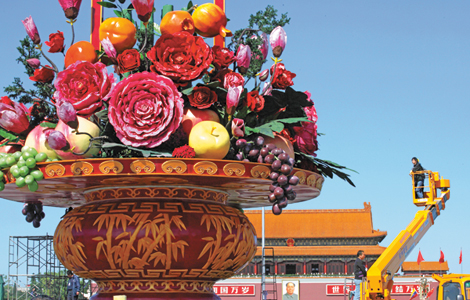
|

|

|

|

|
Today's Top News
Academics evaluate China at conference
Experts examine core values of China, US
China needs to export ‘public goods’: expert
Sowing the seeds of new business
Chinese investors visit Silicon Valley
Two Chinese die in plane crash near Saipan
Destroying Syria's gas arms started
Direction charted to resolve disputes
US Weekly

|

|
